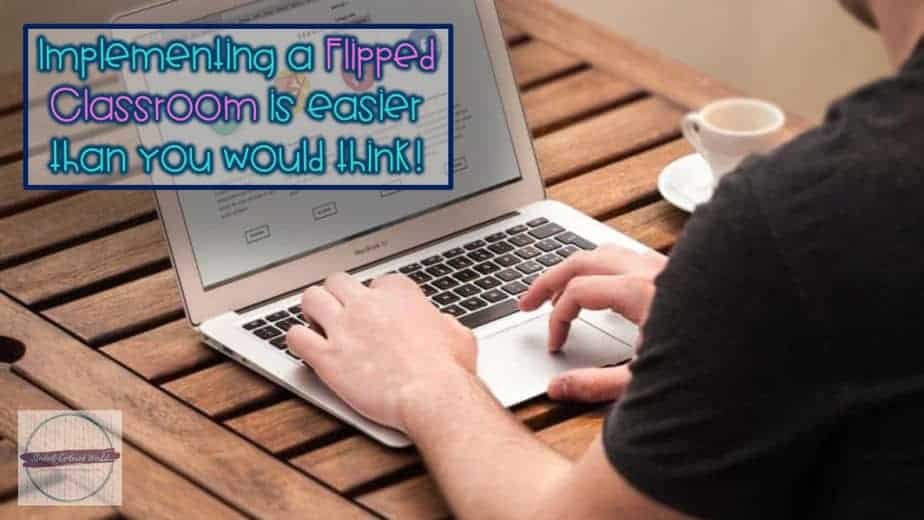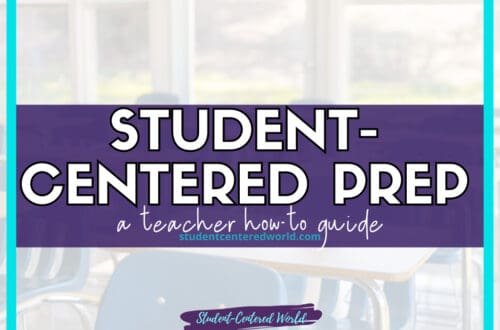What is a Flipped Classroom for Teaching and Learning?
There is a distinct stereotype about what school is supposed to look like and it generally includes direct instruction from a teacher. If not for this, how else would students learn the basic foundation of their curriculum? The flipped classroom approach turns all this on its head and once it is fully implemented in the classroom, as an educator, you will never go back.
One common question that many teachers who are new to student-centered learning often ask is, “How are the students going to learn the initial information if I don’t tell them about it?” As a history teacher by trade, I often get blank stares when I explain that I don’t lecture in my class.
With so much content in that subject area, the same question always comes up, “How is that possible?!” I always tell them, “It’s easy. I run a flipped classroom.”
In the realm of K-12 education (and even into higher education), the term “flipped classroom” has become a significant buzzword, marking a departure from traditional lecture-based pedagogy towards a more interactive and student-centered learning experience. The concept raises questions, especially among educators new to this model, about how students will acquire foundational knowledge without the traditional direct instruction they’re accustomed to.
This guide aims to demystify the flipped classroom approach, offering insights into its implementation and the profound impact it can have on teaching and learning.
Understanding the Flipped Classroom Model
The flipped classroom is a pedagogical model that inverts traditional teaching methods to enhance student engagement and learning. Traditional lectures and in-class activities are reversed in this approach. Instead of first encountering new concepts through in-class time, students are introduced to the material before class through video lectures and pre-class readings. This shift allows classroom time to be used for engaging in active learning strategies, such as case studies, group work, and peer instruction, under the guidance of the teacher.
@studentcenteredworld Replying to @dndwidow I had to edit out a lot of my deeper explanations to fit into the 3 minute window. Please feel free to ask any questions and I’m happy to elaborate! #teachersoftiktok ♬ original sound – Student-Centered World
Aaron Sams and Jonathan Bergmann, pioneers of the flipped model, championed the use of video and other technology-based content delivery methods to facilitate this shift. In a flipped learning environment, the first exposure students have to new content is through pre-recorded lectures, online quizzes, and other preparatory materials that they engage with as independent study.
This foundational information serves as the basis for more interactive and advanced activities during class sessions, where the focus shifts to applying what has been learned in a collaborative setting.
Implementing a Flipped Classroom Effectively
The transition to a flipped classroom requires careful planning and a willingness to adapt traditional pedagogical approaches. Key elements include:
- Content Delivery: Utilize instructional videos, online discussions, and pre-class activities to introduce students to the subject matter before class. Tools like EdPuzzle can enhance engagement with video lectures by embedding questions to check for understanding.
- Active Learning in Class: Replace typical lecture time with active learning techniques that promote deeper understanding and application of course concepts. Activities can include problem-based learning, team-based learning, and experiential learning projects, facilitated by the instructor to guide students’ exploration of the material.
- Assessment and Feedback: Online quizzes and pre-class quizzes serve as valuable tools for assessing students’ understanding of foundational knowledge. During class, real-time feedback through activities and group discussions helps identify areas where further clarification is needed.
Looking at this, most of you probably went right to those students who don’t complete their homework in your mind.
How can our entire lesson be based on something the student may not even complete and be prepared for? The flipped classroom definitely wouldn’t work for me.
I had the same concerns when I first heard about the idea of a flipped classroom. It just didn’t seem realistic. I attended a conference called Techstock at Stockton University in 2016 and I chose a workshop about the flipped classroom. That was the FIRST question that came up.
Our presenter was fabulous. He explained that there was no better way to differentiate than with a flipped classroom. That line in and of itself had everyone leaning in a bit further to hear what he had to say.
When you utilize a program like EdPuzzle, you can see the students’ achievements in real-time. You can group your hands-on lessons based on what you are seeing in the data.
For instance, you can put all the students who did not complete the prep work in one group. Before they do anything, they need to complete the assignment to start (There is something called an “in-class flip” if they participate in the flipped classroom component while in school that I explain below. This might be beneficial overall if your students do not readily have internet access at home).
Then, you can create another group for students who may not have performed well on the flipped assignment (with EdPuzzle, you know before they even get to class). They cannot move forward with the “deeper understanding” activities if they don’t understand the basics.
Then you can get to the meat of the hands-on environment with the students who completed the assignment and did it well. They can be the ones working on the higher-level activities (the “fun stuff”, if you will).
Too often we spend our time focusing on bringing up the lower-tiered students; this method gives those students the extra assistance they need to understand the basic concepts but also reaches the higher-level students who often don’t receive the attention they deserve.
Overcoming Challenges
Adopting the flipped classroom model presents challenges, notably ensuring that all students have access to the necessary technology and can complete pre-class work. Solutions include:
- Bridging the Digital Divide: For students lacking internet access or necessary devices, educators can provide offline resources, loaner devices, or identify community Wi-Fi spots. This ensures that the flipped classroom model is inclusive and accessible to all students.
- Student Accountability: Ensuring that students complete their pre-class work is critical. Strategies like pre-class quizzes and in-class activities based on pre-class content can motivate students to come prepared.
A common hurdle in implementing flipped classrooms is the digital divide, where students may lack access to necessary technology or internet connectivity. Addressing this challenge is essential for ensuring equity in education. Strategies such as conducting surveys to understand students’ tech access, establishing backup plans, and leveraging community resources can help bridge this gap.
For students without home internet access, alternative solutions like loaner devices, using community Wi-Fi or providing offline resources (e.g., DVDs or flash drives) ensure all students can participate in the flipped learning experience.
Many teachers are unwilling to try this because of the lack of access to technology on behalf of their students.

(This post may contain affiliate links that won’t change your price but will share some commission. As an Amazon Associate, I earn from qualifying purchases. Please read our disclosure policy for more information.)
We know within our classrooms, no matter if you are in the richest of rich districts or the poorest of poor, there is a spectrum of socioeconomic needs for the students that are staring back at us. We often need to remember that they have no control over the financial gains or struggles of their family. They are just along for the ride.
It is also an element that can change with the flip of a switch. One job loss or sudden inheritance could change the entire dynamic of the financial structure of a specific child’s family. However, all of our students are entitled to the same education and to be given the same opportunities to be able to excel to their fullest potential in life.
Flipping the classroom can help narrow this divide in education. It is the ultimate tool for differentiating.
However, this still does not change the fact that there are some students out there that do not have access to technology which is so often the focus of a flipped lesson.
This could be because they do not have consistent access to a device, may not have access to the Internet, or do not have the skills to utilize the technology appropriately.
When looking at a bunch of students who may have these barriers and more in the way, it seems like it would be a futile attempt to even try to flip a classroom. However, there are solutions and workarounds for this problem.
The first thing you need to realize is the benefits of the flipped classroom. When a student can work on his or her own, they can work at a pace that is appropriate for them in their learning styles. They do not have to feel embarrassed if they need to rewatch something or go over a concept more than once to understand it.
They are also able to spend time with the teacher engaging with the material as opposed to passively learning it, which is huge in the student-centered model.

Because of this, teachers can interact one-on-one with more students daily which they would not have access to if they were trying to do a full class activity. With the teacher able to circulate more, it creates a better dynamic for the classroom and results for the students.
I always would complete a survey on the first day of school to find out what technology the students had access to. I would not just check their technology access, but I would also focus on what their backup plan was. Sure, a student may have access to a computer, but what if their Internet goes down? What if they can’t use the device that they were planning to use? What is their backup plan?
Many students have neighbors, relatives, or even a local establishment that has Wi-Fi readily available. Having a backup plan is the first step in making certain that your students know all of the bases to make this work. Helping them find a local Wi-Fi spot or a way to access technology that they may not have known before, will help them as they move forward throughout their school careers.
Where there’s a will there’s a way, and students not having access to technology should not be a reason to feel that flipping the classroom is impossible.
As time progresses, there are even more and more opportunities to access the Internet than there weren’t before. Even gaming systems that many students have can access the Internet and be used for schoolwork. There is always an option, and always a Plan B.
Except when there isn’t.
If there are students that just straight up don’t have access to technology outside of school, there are several different options to remedy this on some level depending on what you, your district, and the student’s parents are willing to work with.

If it is a device issue, perhaps there is a program within your school where a student can sign out a device to be able to work from home. There is the option of using alternative locations and times to be able to complete assignments, such as before school, during lunch, during study hall, in the library, etc.
Personally, I always had a computer available so if a student had an issue, they were able to come and speak to me and we would find a time that worked for everybody that was least disruptive to have them complete the assignment. Rarely did I get any pushback from this and they were thankful that I was willing to work with them.
There is always the option as well to have stations set up in your classroom so that if anybody is unable to complete the assignment, they can work on it in class before moving forward to the activity that other students are taking part in. How often do we focus on the kids who didn’t do their work as opposed to spending time with the students who did? This is an opportunity for everybody to be equally attended to while having all their needs still met.
There is always the option as well to send home DVDs or flash drives with the material on them so if the Internet is the issue, but a device is not, there is still a way to access the information. At the end of the day, the teacher could always print out a version of whatever the information is for this student to look over. For instance, if it is a video you could always get the transcript and have them annotate to get the same information, just in a different way.
Another fantastic option is doing an in-class flip.
How to Implement an In-Class Flip
In-class flipping is a transformative approach that breathes new life into traditional teaching methods, making the classroom a dynamic space for active learning. Here’s a practical guide on how to bring this innovative strategy into your classroom, ensuring a more interactive and personalized learning experience for your students.
Step 1: Prepare Your Resources
Before diving into in-class flipping, gather the materials and resources your students will need to explore new concepts on their own. This could range from educational videos and articles to interactive modules and e-books. Ensure these resources are accessible and tailored to the learning objectives of your lesson.
Step 2: Set the Stage in Your Classroom
Design your classroom layout to facilitate independent or small-group learning. Arrange seating in a way that encourages collaboration among students. Having a flexible classroom setup is key, as it allows students to move around freely, switch between activities, and engage with the material in a way that suits them best.
Step 3: Initiate Independent Learning
At the start of the class, direct your students to the prepared resources. Allow them to engage with the new material at their own pace, either individually or in small groups. This phase is crucial as it empowers students to take charge of their learning, promoting autonomy and responsibility.

Step 4: Facilitate Hands-On Application
Once students have absorbed the initial concepts, transition to activities that allow them to apply what they’ve learned. This could include problem-solving exercises, group discussions, or project-based tasks. The key is to make these activities interactive and relevant to the real world, enhancing the learning experience.
Step 5: Offer Immediate Feedback and Support
As your students work through the application phase, circulate the room to provide guidance, clarification, and feedback. This immediate support helps address misunderstandings on the spot and tailors the learning experience to individual needs, ensuring no student is left behind.
Step 6: Reflect and Assess
Conclude the session with a reflection or assessment activity. This could be a group discussion, a quiz, or a peer review session. The goal is to gauge understanding, consolidate learning, and identify areas for further exploration or support.
By following these steps, you can effectively implement an in-class flip, transforming your classroom into a lively, student-centered learning environment. This approach not only fosters active participation and deeper understanding but also prepares students with the skills they need to succeed in a rapidly changing world.
The key is to always be thinking about another way to make the magic happen. Flipping the classroom will change everything you know about education and finding ways to help students access that information outside of your classroom will benefit everyone in the long run. It’s not like your class is the only one that the student will ever need to use technology outside of the classroom, not in this day in age.
The Impact of Flipped Classrooms
Evidence suggests that flipped classrooms can lead to positive results in student learning, including higher levels of student engagement, better retention of course material, and improved performance on assessments. The active learning environment encourages students to become more responsible for their learning, while also providing opportunities for collaborative learning and critical thinking.
Flipping the classroom represents a significant shift in educational practice, moving away from traditional methods towards a more interactive, student-centered approach. By effectively leveraging pre-class work and maximizing classroom time for engaging activities, educators can enhance student learning experiences, foster a deeper understanding of course material, and prepare students for higher-level critical thinking and problem-solving tasks.
The value of a flipped class lies not just in the inversion of content delivery and classroom activities but in its ability to transform the educational landscape by promoting active, engaged, and meaningful learning experiences.
Stop Driving the Teacher Struggle Bus
Are you struggling with student engagement, apathy, or keeping your class on track?
💫💫 There’s hope! 💫💫
Join my free teacher workshop “Choosing Choice” and in just 45 minutes, you’ll craft a practical plan to revitalize your teaching. Discover the magic of student choice in boosting engagement, gain quick implementation ideas, and explore strategies for year-long success.
Unlike overwhelming workshops, my approach guides you in real-time, providing more classroom options, reducing stress, and giving you more personal time.
Plus, you’ll earn a 45-minute professional development certificate and have 7 days of access.
Don’t miss this chance to transform your teaching; click below to secure your spot now!
This article was originally published on July 1, 2020







